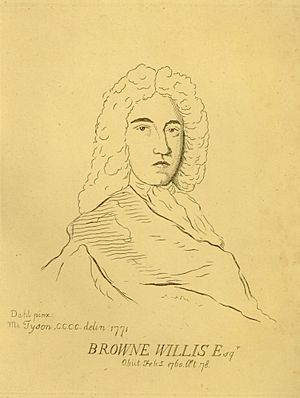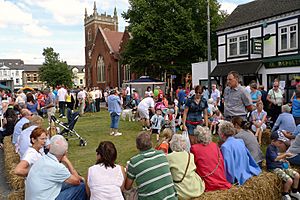Browne Willis facts for kids
Browne Willis (born 16 September 1682, died 5 February 1760) was a very interesting person from history. He was an antiquary, which means he loved studying old things like ancient buildings and coins. He was also an author, a numismatist (someone who studies coins), and even a politician. He was a Member of Parliament (MP) from 1705 to 1708.
Contents
Browne Willis's Early Life
Browne Willis was born in a place called Blandford St Mary in Dorset, England. He was the oldest son of Thomas Willis and Alice Browne. His grandfather was a famous doctor named Dr. Thomas Willis.
Browne Willis went to school at Bechampton and then at Westminster School. Later, he studied at Christ Church, Oxford University. In 1700, he joined the Inner Temple, which is a place where people train to become lawyers.
In 1707, he married Katherine Eliot. He also joined the Society of Antiquaries in 1717. This group was for people who loved studying history and old things.
Browne Willis's Political Career
In 1705, Browne Willis was chosen to be a Member of Parliament (MP) for the town of Buckingham. He held this important job for three years, until 1708. As an MP, he helped make decisions for the country.
Browne Willis's Published Works
Browne Willis was a very busy writer! He wrote many books about history, especially about old churches and Parliament. Here are some of his famous works:
- Notitia Parliamentaria, Volume 1 (1715)
- Survey of St David’s Cathedral (1716)
- Notitia Parliamentaria, Volume 2 (1716)
- Mitred Abbies, Volume 1 (1718)
- An Survey of the Cathedral-Church of Landaff (1718 or 1719)
- Mitred Abbies, Volume 2 (1719)
- Survey of St Asaph (1720)
- Survey of Bangor Cathedral (1721)
- Survey of York, Durham, Carlisle, Chester, Man, Lichfield, Hereford, Worcester, Gloucester, and Bristol (1727)
- Survey of Lincoln, Ely, Oxford, and Peterborough (1730)
- A Table of the Gold Coins of the Kings of England (1733)
- Parochiale Anglicanum (1733)
- Notitia Parliamentaria, Volume 3 (1750)
- History of the Town, Hundred, and Deanery of Buckingham (1755)
St Martin's Church, Fenny Stratford
Browne Willis decided to build a church in Fenny Stratford. This church, called St. Martin's Church, was built between 1724 and 1730. It was built on the spot where an old chapel used to be.
He built the church to remember his grandfather, Dr. Thomas Willis. His grandfather was a famous doctor who lived in London and passed away on St. Martin's Day (November 11th) in 1675.
The Fenny Poppers Tradition
Browne Willis started a special tradition at St. Martin's Church. He arranged for a sermon (a religious talk) to be given every St. Martin's Day to remember his grandfather. He also paid for a dinner for local church leaders and important people.
Around this time, the tradition of firing the "Fenny Poppers" began. These are six small cannons! Even though we don't know exactly when they were first used, they became part of the St. Martin's Day celebration.
In 1740, Browne Willis bought a house. The money from renting this house was used to pay for the sermon and the gunpowder for the Fenny Poppers. This tradition continued even after Browne Willis died in 1760.
The six poppers were remade in 1859 because one of them burst. They are still used today! They weigh about 19 pounds each. They are fired three times on St. Martin's Day: at noon, 2 PM, and 4 PM. This tradition is not connected to Remembrance Day, which is also on November 11th.
The poppers are also fired for other special events. For example, they were used when Queen Victoria died, at the start of the new millennium, for the 100th birthday of Queen Elizabeth, the Queen Mother, and for the Diamond Jubilee of Queen Elizabeth II.



